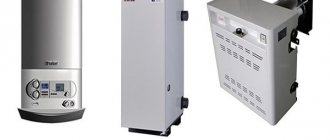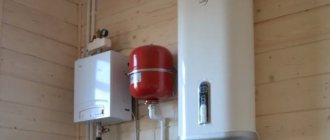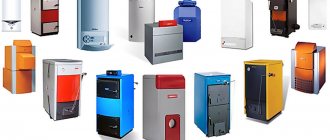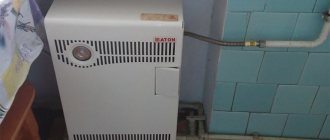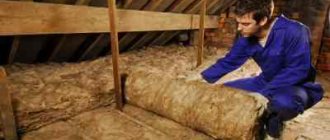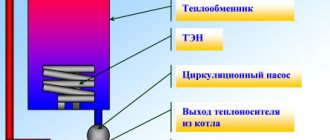If you want to know which gas boiler is best for a private house of 200 sq. m., then “you are welcome to our hut” - we will examine this question below.
In particular, we will consider what power of the heating unit we need to include in the calculations, whether it is necessary to reserve power for the production of hot water in the domestic hot water supply, and whether it is worth using a cascade scheme for installing heat generators with such a house area.
How to choose a fuel type? Is gas, electricity, solid or liquid fuel better?
House with an area of 200 sq.m. has no significant limitations on area, which gives owners greater freedom in choosing a boiler based on the type of fuel used. In such a cottage, you can equip a separate boiler room and find a place for a floor-standing boiler and a fuel supply for it, or give preference to compact wall-mounted gas or electric models.
- Gas.
It is a very common type of fuel due to its low heating costs compared to other options. Gasification has already been carried out in most regions of Russia, so a gas boiler for a 200 m2 house can be installed there without problems. Even if there is no main gas, many boilers can be converted to use liquefied gas. Gas boilers are produced by all well-known manufacturers (Vaillant, Protherm, Bosch, Baxi and others). Among the most popular series are the Bear, Panther, turboTEC, Luna-3, etc. boilers. When purchasing a gas boiler, you can count on an average efficiency of about 89-92%. Finding specialists in the installation and repair of gas boilers is not a problem, since this type of heating equipment is well known to specialists. - Electricity.
An environmentally friendly, but expensive type of fuel for boilers for a house of 200 sq.m. Due to high heating costs, few owners prefer this option, but the convenience of electric boilers cannot be denied. They are lightweight, ultra-compact, silent, equipped with advanced automation, easy to install and operate. Another big plus is high efficiency (up to 99.5%). Boilers from the Vaillant eloBLOCK or Protherm Skat series are popular. - Solid fuel.
Solid fuel boilers for a house with an area of 200 square meters are effective, but not very common. This group accounts for no more than 15% of all heating boilers installed in Russian houses and cottages. The reasons are simple: not everyone is comfortable storing a supply of firewood, coal or pellets. In addition, solid fuel boilers emit quite a lot of combustion products into the atmosphere and require frequent maintenance (cleaning from soot). However, this type of heating is indispensable in areas without gasification. Efficiency rates are usually in the range of 80-90%. - Liquid fuel (fuel oil, kerosene, diesel).
They are not often used due to the need to allocate a room for a boiler room and a sufficiently large container for storing fuel. Suitable for non-gasified residential areas. They show efficiency comparable to gas boilers.
No. 2. Types of electric boilers by type of heating element
Depending on how the water is heated, all boilers are divided into heating elements, electrode and induction.
Heating elements new boilers
This is the most popular version , and so popular that when talking about electric boilers, as a rule, they mean designs with heating elements. This unit works on the principle of a boiler. Electricity is supplied to a tubular electric heater (TEH), it heats up and transfers heat to water, which is used as a coolant. The heating element consists of a nichrome spiral and a durable shell made of steel, aluminum or titanium. The space between the spiral and the shell is filled with quartz sand or other dielectric filler.
The rated power in such boilers is achieved abruptly, approximately 10-15 minutes after switching on. Heating element boilers operate in flow mode and can be single-circuit or double-circuit. As a rule, several heating elements are placed in the boiler tank.
Since there is no direct contact of the heating coil with water (the dielectric plays the role of a separator), there is no need to be afraid of a short circuit. The main problem of such boilers is different. scale appears on it relatively quickly , which can gradually damage the boiler. To slow down this process or even avoid it completely, it is better to use distilled water in the system. Special liquids are also sometimes used. The boilers are protected from overheating of the coolant by a thermal regulator, but if a leak occurs, the unit risks overheating and failure.
Electrode (ion) boilers
The design of this boiler involves the presence of two electrodes immersed in a heat exchanger. Electrical energy is supplied to them, due to which a potential difference is created. Due to the presence of salts in the coolant, it turns into a current conductor. Electricity passing through the high resistance electrolyte causes it to heat up. Just a couple of minutes is enough for the boiler to reach its rated power. Specially prepared water or ethylene glycol-based liquid is used as an electrolyte (coolant)
Boilers of this type are quite economical , and to provide the same thermal power as a heating element boiler, they consume almost half as much electricity. Such units, as a rule, have reliable, well-thought-out automation and rarely fail, since, in fact, there is nothing to break here. If a leak occurs in the system, overheating will not occur - there is no electrolyte. Electrode boilers also perform well under unstable voltage conditions. If it drops down to 180 V, the unit will continue to operate and produce heat.
The only downsides are the cost of the equipment and the need to use specially prepared coolant. Its composition will determine how much energy the boiler will spend on heating. Another nuance is the need for reliable grounding. The electrodes will have to be changed periodically.
Induction boiler
Boilers of this type began to be used back in the 80s of the last century, but at first they were installed only in production. The production of household models began only towards the end of the 90s. Their operating principle is quite complex and resembles a transformer. The heart of the unit is an induction coil, which converts electrical energy into a magnetic field, directing it to the core. The latter is a system of steel pipes with coolant inside.
The system performed well. Induction boilers are economical and very compact , durable (service life 30 years or more) and fireproof, and the problem of scale is not a problem with them. There are no strict requirements for the coolant, as in the two previous types of boilers - even purified petroleum products can be filled.
The main disadvantage is the high price . In addition, induction boilers weigh decently, despite their miniature dimensions. You won’t be able to find a model lighter than 20 kg.
Which boiler is better to choose depends on your budget and your requirements - all three types can be found on sale.
Power calculation for a boiler for a house with an area of 200 square meters
Having chosen the type of fuel, you need to calculate the required power.
In regions of Russia with a temperate climate (no severe, prolonged cold in winter), you can use a thermal conductivity indicator of 1 kW of power per 10 m2 of area.
Simply multiplying the coefficient by the area will not work, since you also need to take into account the efficiency of the selected boiler, the degree of insulation of the house, the percentage of glazing, the number of doors and many other indicators. Therefore, when purchasing a boiler, a power reserve of 10-30% is included.
Based on this, for a house with an area of 200 sq.m. A 21-24 kW boiler is suitable.
Excess power (for example, 30 kW or more) is not the best option if the boiler will be used only for heating. When operating at less than full capacity, boilers' efficiency is significantly reduced.
Reserve for heating tap water
If you want to use your gas boiler for hot water supply, then you should decide how exactly you will prepare hot water for the water supply. This determines what reserve for hot water supply you will need to include in your calculations.
If you use a double-circuit boiler, then to reliably heat tap water in instantaneous heater mode, you need to set at least 30 percent of the power.
That is, for our case this is a minimum of 6 kW, and the total power is at least 26 kW. And that is not all.
If you use two water points in the bathrooms, one point in the kitchen, a bath, a shower, and also heat water for the bath with a boiler, then you will have to spend not 30, but 50 percent on hot water.
That is, at the output we already have 10 kW for DHW or 30 kW of total power.
However, if you decide to use a single-circuit boiler and an indirect heating boiler, then you should set the minimum power for hot water supply in the region of 2-3 kW.
Of course, if you install a standard 100 liter 24 kW boiler, then for quick heating it can take on all 20 kW.
But in the case of using only 3 kW of reserve, it will also heat the water. Only it will take about 4 times longer to do this.
Although, with a reserve of 3 kW, water in the BKN of 100 liters is heated to +55 degrees Celsius in just 40-50 minutes.
Which boiler is better for a house of 200 sq.m.: wall-mounted or floor-mounted?
In a house or cottage with an area of 200 square meters, you can easily find a place for a standard floor heating boiler. Such models have no restrictions on the type of fuel; they are extremely diverse. For example, it is possible to buy a cast iron heating boiler, which can only be installed on the floor due to its heavy weight. Cast iron heat exchangers are the most durable and stable due to their high corrosion resistance.
A wall-mounted heating boiler will also be an excellent choice for a private house of 200 m2. This equipment has compact dimensions and less weight compared to floor-standing units. Many wall-mounted models have more advanced automation and many “smart” functions.
Operating principle
The operation of a single-circuit floor-standing gas boiler consists of flow-through heating of the coolant using thermal energy obtained from fuel combustion.
The liquid enters the heat exchanger, receives the maximum possible heating for a given operating mode and enters a three-way valve . This is a unit where the hot coolant is mixed in a given proportion with the colder return flow.
The more return is added, the lower the temperature of the liquid entering the heating circuit. This is how the room heating mode is adjusted. The coolant moves under the action of a circulation pump, and the air supply and smoke removal are controlled by a turbofan.
The operation of all components is under continuous monitoring of a self-diagnosis system - a network of sensors installed on important components and parts of the boiler.
If abnormal situations occur or any elements fail, the sensors signal to the electronic control board, which immediately generates an error signal.
Some types of malfunctions cause immediate shutdown and blocking of the boiler for safety purposes; the control unit simply notifies the user about minor malfunctions.
IMPORTANT!
All problems that arise must be resolved only by qualified specialists with appropriate clearance. Unauthorized interference with the boiler design is an administrative offense.
Single-circuit or double-circuit?
If the boiler has only one circuit, then it by itself can only provide heating to the house. If you need to heat water for a house with an area of 200 square meters, you will need to buy and connect a storage boiler. This usually requires a connection kit recommended by the manufacturer.
Double-circuit boilers are initially designed for heating and hot water. However, it is recommended to use such equipment only when the need for hot water is small, otherwise the supply may be unstable or completely insufficient.
Ideal models
The main part of any boiler is the internal heat exchanger. The efficiency of the device, its performance, and safety factor depend on the selected properties of the material. The best choice would be stainless steel, copper, cast iron. The greatest reliability is provided by single-circuit heat exchangers, an open type of burner that does not require the creation of a 5-7-meter chimney with natural draft.
When choosing which gas boiler is better, inexpensive models can be considered in this order:
Heating with solid fuel
The choice of boiler type in the absence of a gas pipeline is obvious and depends on the existing infrastructure. Heating a 200 m² house with solid fuel is provided by the PROTHERM BOBER 40 DLO model. It is built according to a single-circuit scheme with the possibility of connecting a hot water supply or a heat accumulator.
Wood or coal can be used as fuel. The combustion time for a full load of firewood is at least 2 hours, and for coal - up to 4. It is more efficient to heat and collect water in a heat accumulator.
Additional characteristics of the model:
The market offers a wide range of equipment from which you can choose the best option for a particular case, from the simplest boilers to systems with turbocharged combustion chambers from brand manufacturers.
Source
Is an open or closed chamber better for a gas boiler?
Atmospheric traditional boilers with an open chamber take air for combustion of gas fuel directly from the room, so they require good ventilation. The combustion products are removed through a classic vertical chimney. These are boilers of simple design, easy to repair and maintain.
A closed combustion chamber is a more modern and technologically advanced option. Such boilers for a 200 m2 cottage use a coaxial (lateral, passing through the wall) chimney to take in air from the street and exhaust smoke. Boilers with a closed chamber have a built-in fan. They are considered the safest to operate, but their cost is higher than that of atmospheric models.
Should we install a cascade of boilers?
Or maybe install a cascade of two gas boilers? What advantages does this scheme have in our case? For example, you can put 2 gas boilers in a cascade, each with a power of 15 kW.
It will be possible to use 1 boiler in a cascade in the off-season, and in winter connect both boilers.
If one boiler fails, the second heat generator will be able to maintain an acceptable temperature in the house during repairs.
Is it necessary to put 2 gas boilers of 20 or 30 kW in a cascade? No. In this case, the whole point of such a scheme is lost; we will simply have 1 backup boiler “just in case.”
Source
The best boiler models for a house with an area of 200-240 square meters
In the Teplo-Comfort online store you can buy several boilers with suitable parameters. Below we will talk about the most popular models. This is a wall-mounted equipment with a power of 21-24 kW, running on gas, electricity and solid fuel.
Gas wall-mounted boiler Protherm Cheetah 23 MTV and MOV
23 MTV 23 MOV
Power: 23 kW
A modern double-circuit heating unit for heating and domestic hot water with smooth power control in a laconic white body. The MTV model with a closed combustion chamber is equipped with a coaxial flue gas system, while the MOV has an open chamber and is connected to a standard vertical chimney. The boilers have an informative LCD display to simplify setup and operation of the equipment, high efficiency of 93.2%, a built-in expansion tank and a plate heat exchanger. Automatic microprocessor load control of the heating and hot water circuit, multi-level protection system, several operating modes, including ECO for economical heating of hot water.
Price: 58698-61640 rubles
Delivery in Moscow, Moscow region and all regions of Russia (transport companies DPD, SDEK, PEK).
Gas wall-mounted boiler Protherm Jaguar 24 JTV
Jaguar 24 JTV
Power: 24 kW
A double-circuit boiler that can cope with heating rooms and preparing hot water. It has a favorable price-quality ratio and is a kind of response to budget models from other manufacturers. Has an efficiency of 90.2%. It has a safe closed combustion chamber and supports the removal of combustion products through a coaxial chimney. Volatile. There are all the necessary protective functions, flame modulation, automatic diagnostics, two separate heat exchangers, LCD display, built-in microprocessor. The boiler operation is regulated using knobs (mechanical thermostats), and not buttons, as on many other models.
Price: 46230 rubles
Delivery in Moscow, Moscow region and all regions of Russia (transport companies DPD, SDEK, PEK).
Gas wall-mounted boiler BAXI ECO Nova 24 F
ECO Nova 24 F
Power: 24 kW
Double-circuit boiler (for heating and domestic hot water) of a traditional efficiency class with an efficiency of 93% and a closed combustion chamber. Unlike many other economy-class boilers, ECO Nova 24 is equipped with a brass hydraulic group. There is an LCD display, electronic flame modulation and soft ignition, a turbine flow sensor, a primary heat exchanger made of copper and a secondary heat exchanger made of stainless steel. Built-in pressure gauge and automatic bypass. Multi-stage security system, including electronic self-diagnosis, digital temperature display, traction sensor, freeze and overheat prevention functions and other useful features.
Price: 43899 rubles
Delivery in Moscow, Moscow region and all regions of Russia (transport companies DPD, SDEK, PEK).
Gas wall-mounted boiler BAXI ECO-4S 1.24 F, 24 and 24 F
24 F 1.24 F
Power: 24 kW
1.24 F is a single-circuit model, and 24 F is a double-circuit model (DHW and heating). These boilers have an efficiency of 91.2% and 92.9%, respectively. Models with the letter F in the name have a closed combustion chamber. The hydraulic group is made of composite materials, which ensures an affordable price for boilers. The Baxi Eco-4S series has a full range of modern functions, including protection against overheating or freezing, a pressure gauge, a draft sensor, a display and a diagnostic system that stores the latest operating errors. Despite the compactness of the body and relatively light weight, these boilers are real mini-boiler rooms.
Price: 43899-52470 rubles
Delivery in Moscow, Moscow region and all regions of Russia (transport companies DPD, SDEK, PEK).
Gas wall-mounted boiler BAXI LUNA-3 240 i and 240 Fi
240 i 240 Fi
Power: 24 kW
Double-circuit boilers designed for heating houses up to 240 m2 and for preparing domestic hot water. The 240 i model is equipped with an open combustion chamber, and the 240 Fi is equipped with a closed combustion chamber (with forced removal of combustion products into a coaxial chimney). LUNA-3 is one of the most popular series of Italian Baxi boilers. The boilers are protected from major threats (starting up without water, freezing, overheating, lack of draft, etc.) and have an electrical auto-restart function. There is a weather-dependent temperature control system. Efficiency - 93%.
Price: 66184-73875 rubles
Delivery in Moscow, Moscow region and all regions of Russia (transport companies DPD, SDEK, PEK).
Gas wall-mounted boiler BAXI ECO Four 24 and 1.24
24 F 1.24 1.24 F
Power: 24 kW
Energy-efficient boilers with ultra-compact overall dimensions, which are suitable not only for houses, but also for apartments. Models 1.24 are single-circuit (for heating only), and 24 are double-circuit (heating and domestic hot water). The letter F in the name means a closed combustion chamber. These heating boilers for rooms up to 240 square meters are easy to maintain and install, equipped with a convenient LCD display, security and self-diagnosis functions. Can be converted and reconfigured to run on liquefied gas. ECO Four boilers are adapted for the Russian Federation, are comfortable to use, have low noise levels and an efficiency of 91.2-92.9%.
Price: 48893-62189 rubles
Delivery in Moscow, Moscow region and all regions of Russia (transport companies DPD, SDEK, PEK).
Gas wall-mounted boiler Vaillant turboTEC plus VUW 242/5-5 and VU INT 242/5-5
VUW 242/5-5 VU INT 242/5-5
Power: 24 kW
Modern and technologically advanced boilers from one of the most popular Vaillant series (Germany). They have a safer closed combustion chamber (turbocharged), and are compatible with a coaxial chimney (through the wall). VU is a single-circuit model, and VUW is a dual-circuit model. The efficiency of turboTEC plus boilers is 91%. They are equipped with a chromium-nickel steel burner with electric ignition, an information panel, security and self-diagnosis functions. Compatible with eBus standard automatics, support several operating modes (partial power, “winter-summer”). These boilers are safe and can be installed even in a residential area (no special installation of a boiler room is required).
Price: 98268-109342 rubles
Delivery in Moscow, Moscow region and all regions of Russia (transport companies DPD, SDEK, PEK).
Gas floor-standing boiler BAXI SLIM 1.230 and 2.230
1.230 iN 4E 1.230 i 4E 1.230 Fi 4E 2.230 i 4E 1.230 FiN 4E
Power: 23 kW
As the name of the series suggests (Slim - “thin, narrow”), these boilers have a small width and increased height in comparison with analogues. Thanks to this feature, they take up less space on the floor. Baxi Slim has a reliable cast iron heat exchanger that is resistant to corrosion. The efficiency of these boilers is 90.2%. Models of type 1.230 are single-circuit, and 2.230 are double-circuit. The letter F in the model name means a closed combustion chamber, and N means the absence of a built-in expansion tank and circulation pump. Each model is capable of heating up to 230 m2 of area of a house, cottage or industrial premises.
Price: 85860-164744 rubles
Delivery in Moscow, Moscow region and all regions of Russia (transport companies DPD, SDEK, PEK).
Electric wall-mounted boiler Vaillant eloBLOCK VE 21 and VE 24
eloBLOCK VE 21 eloBLOCK VE 24
Power: 21 or 24 kW
Boilers for houses, apartments or other premises with an area of 210 or 240 m2 (depending on the chosen model). They have an efficiency of 99%, one heating circuit, a steel heat exchanger, a microprocessor, an information display, a built-in pressure gauge and expansion tank, and a number of protective functions. Supports smooth power control and coolant temperature control via the display. The connection of the voltage stabilizer has been simplified, and there is built-in weather-compensating automation. The boilers are light in weight and compact in size, and do not require a chimney or a separate boiler room for installation.
Price: 72636-74882 rubles
Delivery in Moscow, Moscow region and all regions of Russia (transport companies DPD, SDEK, PEK).
Electric wall-mounted boiler Protherm Skat 21 or 24 (380 V)
Skat 21 Skat 24
Power: 21 or 24 kW
A powerful electric fuel boiler with European build quality and an excellent price-quality ratio. Lightweight, compact, safe and environmentally friendly option with a 2-year manufacturer's warranty. It has a very high efficiency of 99.5% and is capable of providing heat for 210-240 sq.m. area (depending on the power of the selected boiler). It has one circuit; to prepare DHW you will need to purchase and install an additional storage boiler. Connects to a three-phase network (380 V), no chimney or separate boiler room is required.
Price: 68532 rubles
Delivery in Moscow, Moscow region and all regions of Russia (transport companies DPD, SDEK, PEK).
Solid fuel floor-standing boiler Protherm Beaver 30 DLO
Beaver 30 DLO
Power: 24 kW
Reliable boiler with a two-pass cast iron 5-section heat exchanger for floor placement. It uses wood or coal as fuel. Single-circuit (for heating only, or for preparing hot water in a separate storage boiler), with an open combustion chamber (takes air directly from the room, connected to a vertical chimney) and efficiency of 90.5%. Beaver 30 DLO is a non-volatile boiler; it does not require a connection to the electrical network for its operation. Perfect for regions without gasification or with unstable power supply.
Price: 114375 rubles
Delivery in Moscow, Moscow region and all regions of Russia (transport companies DPD, SDEK, PEK).
How to take ceiling heights into account when calculating?
Since many private houses are being built according to individual projects, the methods for calculating boiler power given above will not be suitable. To make a fairly accurate calculation of a gas heating boiler, you need to use the formula: MK = Qt*Kzap. Where:
- MK – design power of the boiler, kW;
- Qt – predicted heat loss of the building, kW;
- Kzap is a safety factor that is 1.15 to 1.2, i.e. 15-20%, by which experts recommend increasing the design power of the boiler.
The main indicator in this formula is the predicted heat loss of the building. To find out their value, you need to use another formula: Qt = V*Pt*k/860. Where:
- V is the volume of the room, cubic meters;
- Рt - difference between external and internal temperatures in degrees Celsius;
- k is the dissipation coefficient, which depends on the thermal insulation of the building.
The dissipation coefficient varies depending on the type of building:
- For buildings without thermal insulation, which are simple structures made of wood or corrugated iron, the dissipation coefficient is 3.0-4.0.
- For structures with low thermal insulation, typical for buildings with single brickwork with ordinary windows and a roof, the dissipation coefficient is taken to be 2.0-2.9.
- For houses with an average level of thermal insulation, for example buildings with double brickwork, a standard roof and a small number of windows, take a dispersion coefficient of 1.0-1.9.
- For buildings with increased thermal insulation, well-insulated floors, roofs, walls and double-glazed windows, a dispersion coefficient of 0.6-0.9 is used.
For small buildings with good thermal insulation, the design power of heating equipment can be quite small. It may happen that there is simply no suitable gas boiler on the market with the required characteristics. In this case, you should purchase equipment whose power will be slightly higher than the calculated one. Automatic heating control systems will help smooth out the difference.
Some manufacturers have taken care of the convenience of customers and have placed special services on their Internet resources that make it possible to calculate the required boiler power without any problems. To do this, you need to enter the following data into the calculator program:
- temperature that must be maintained in the room;
- average temperature for the coldest week of the year;
- need for hot water supply;
- presence or absence of forced ventilation;
- number of floors in the house;
- ceiling height;
- information about floors;
- information about the thickness of external walls and the materials from which they are made;
- information about the length of each wall;
- information about the number of windows;
- description of the type of windows: number of cameras, glass thickness, etc.;
- dimensions of each window.
Once all the fields are filled in, you can find out the estimated power of the boiler. Options for detailed calculations of the power of boilers of various types are clearly presented in the table:
This table has already calculated some options, you can use them as the correct ones in advance (click on the picture to enlarge)
Comparative table of boilers for a house 200-240 m2
| Name | Homeland of the brand | Number of circuits | Combustion chamber type | Fuel | Power | Efficiency | Price |
| Wall mounted | |||||||
| Protherm Cheetah 23 MOV | Slovakia | double-circuit | open | gas | 23 kW | 90,3 % | 58698 rubles |
| Protherm Cheetah 23 MTV | Slovakia | double-circuit | closed | gas | 23 kW | 93,2 % | 61640 rubles |
| Protherm Jaguar 24 JTV | Slovakia | double-circuit | closed | gas | 24 kW | 90,2% | 46230 rubles |
| BAXI ECO Nova 24 F | Italy | double-circuit | closed | gas | 24 kW | 93% | 43899 rubles |
| BAXI ECO-4S 24 | Italy | double-circuit | open | gas | 24 kW | 91,2% | 43899 rubles |
| BAXI ECO-4S 1.24 F | Italy | single-circuit | closed | gas | 24 kW | 92,9% | 49071 rubles |
| BAXI ECO-4S 24 F | Italy | double-circuit | closed | gas | 24 kW | 92,9% | 52470 rubles |
| BAXI LUNA-3 240i | Italy | double-circuit | open | gas | 24 kW | 91,2% | 66184 rubles |
| BAXI LUNA-3 240 Fi | Italy | double-circuit | closed | gas | 24 kW | 93 % | 73875 rubles |
| BAXI ECO Four 1.24 | Italy | single-circuit | open | gas | 24 kW | 91.2 kW | 48893 rubles |
| BAXI ECO Four 1.24 F | Italy | single-circuit | closed | gas | 24 kW | 92,9% | 55094 rubles |
| BAXI ECO Four 24 | Italy | double-circuit | open | gas | 24 kW | 91,2 % | 55809 rubles |
| BAXI ECO Four 24 F | Italy | double-circuit | closed | gas | 24 kW | 92 % | 62189 rubles |
| Vaillant turboTEC plus VUW 242/5-5 | Germany | double-circuit | closed | gas | 24 kW | 91% | 109342 rubles |
| Vaillant turboTEC plus VU INT 242/5-5 | Germany | single-circuit | closed | gas | 24 kW | 91 % | 98268 rubles |
| Vaillant eloBLOCK VE 21 | Germany | single-circuit | — | electricity | 21 kW | 99% | 72636 rubles |
| Vaillant eloBLOCK VE 24 | Germany | single-circuit | — | electricity | 24 kW | 99% | 74882 rubles |
| Protherm Skat 21 (380 V) | Slovakia | single-circuit | — | electricity | 21 kW | 99,5 % | 66983 rubles |
| Protherm Skat 24 (380 V) | Slovakia | single-circuit | — | electricity | 24 kW | 99,5 % | 68532 rubles |
| Floor-standing | |||||||
| BAXI SLIM 1.230 iN 4E | Italy | single-circuit | open | gas | 23 kW | 90,2 % | 85860 rubles |
| BAXI SLIM 1.230 i 4E | Italy | single-circuit | open | gas | 23 kW | 90,2 % | 103509 rubles |
| BAXI SLIM 1.230 FiN 4E | Italy | single-circuit | closed | gas | 23 kW | 90,2 % | 114063 rubles |
| BAXI SLIM 1.230 Fi 4E | Italy | single-circuit | closed | gas | 23 kW | 90,2 % | 131354 rubles |
| BAXI SLIM 2.230 i 4E | Italy | double-circuit | open | gas | 23 kW | 90,2 % | 164744 rubles |
| Protherm Beaver 30 DLO | Slovakia | single-circuit | open | firewood, coal | 24 kW | 90,2 % | 114375 rubles |
Why count if you can buy a boiler with a power reserve?
Sometimes boilers have a capacity reserve. This is good when the reserve is no more than 25%. Especially when the family plans to develop the area: complete a swimming pool, sauna, or other heated area. When the required power is exceeded significantly, the owner spends extra money, and the equipment operates in abnormal mode:
Conclusion: frequent switching on and off wastes more fuel than continuous operation. Buying a boiler with excess power not only makes no sense, but is also harmful to the budget and equipment.
Why contact a specialist?
We found out that buying a boiler from the square is wrong. It is important to consider the heat loss of the building. For example, a house of 300 m² can be heated by a 15 kW boiler if all surfaces are thoroughly insulated. And a house of 150 m² may require 30 kW equipment with thin walls and uninsulated roof and ventilation.
There are hundreds of standards and regulations on this topic, there are dozens of formulas. Sometimes one thing contradicts the other, or standards change and it is difficult for a non-professional to understand whether these requirements are relevant. You can calculate all this armed with a stack of reference books. Or contact specialists who will make accurate calculations in the program and explain all the details. They will help you save money, time, and model an efficient home heating system.
Source

